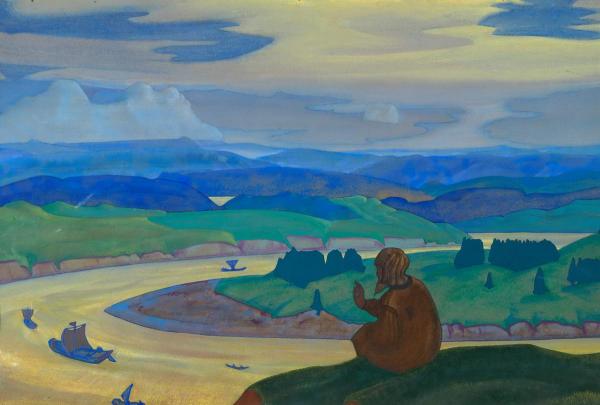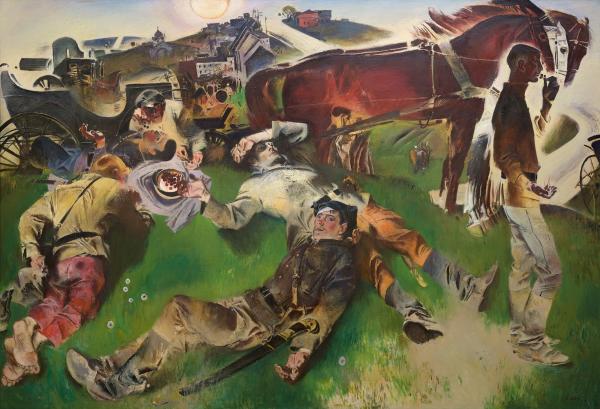The artist is Roerich

Procopius of the righteous – Holy Russian Orthodox Church. Came from a noble Prussian family, Catholic religion. He arrived as a merchant in Veliky Ustyug (XIII century), then he lived in Novgorod, where he accepted Orthodoxy and went to the monastery. For suffering, he was given a gift of providence and salvation of people from death. According to legend, Procopius had a favorite place on the high bank of the Sukhoni River (not far from Veliky Ustyug), where he loved to look from the cliff into the distance and pray for people who floating along the troubled river. Here he asked himself to bury, which was done.
Nikolai Roerich. In search of Shambhala. Exhibition catalog in Malaga. 2019. With. 56.
In the early 1910s, Roerich, like many progressive cultural figures, was deeply worried about the Duma about the Motherland, its future. He acutely felt the possibility of war, the emergence of fracture events, the need to evaluate what is happening.
The content of his paintings by the so -called pre -war series is the knowledge of the scientist, the thoughts of the philosopher, intuition and poetic fantasy of the artist. To embody complex abstract ideas, the master widely uses the techniques of symbolism.
The painting “The righteous for unknown floating praying” is adjacent to the pre -war series. The creation of this canvas was preceded by something else – “the righteous Procopius takes a cloud from Ustyug the Great” (1913). The plots of both paintings are built on the material of ancient legends about the ascetic of Procopius, which has repeatedly saved the homeland from trouble. In the foreboding of world-historical changes, Roerich addresses the legends created by the people and the legends of the ascetic and in an allegorical form expresses his thoughts about Russia.
The picture depicts the vast expanses of the native land, its powerful forests, a fast full -flowing river, juicy meadow grasses. In the foreground on a high hill sits the righteous Prokopiy in a dark robe. It is inscribed in the image of nature as part of it. The righteous Procopius prays and is confident in his prayer for the land of the Russian and its travelers. Calmness is spilled everywhere – in a confident fast movement of the roles, in smooth linear rhythms of shores and hills. The coloristic gamut, built on a combination of blue, green, yellow tones, is finely cooled. In an allegorical form, Roerich expressed his faith in the greatness of the greatness, stamina of Russia, its power in the picture.
During the First World War, Roerich’s social activity unfolded widely. He advocates the creation of an international pact for the protection of cultural values. This undertaking has become a matter of his whole life. After the death of the artist, in 1954, in the Hague, on the basis of the so -called “Roerich Pact”, the Final Act of the International Convention on the Protection of Cultural Values was signed in the event of an armed conflict. Soon this convention was ratified by many countries, including the USSR.
Procopius of the righteous, foolish Christ for the sake of blessed, lived in the second half of the XIII century and was a native of a rich merchant family. He came to the great Ustyug from Novgorod and settled on the porch of the Assumption Cathedral. The holy righteous became famous as a visionary and a miracle worker. With his prayers, he took a stone cloud from Ustyug and saved the city from a terrible disaster. In Veliky Ustyug, a stone has been preserved to this day, on which Blessed was like to sit, escorting the Ustyuzhsky merchant merchant people in an unknown, full of danger. Nearby, the temple of his name rises, erected, according to legend, over his burial, which had numerous healings. The Holy Procopius of the righteous is especially revered in the Russian North and, above all, as the patron of traders and traveling.


